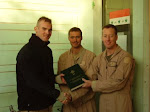Then all those virgins got up and trimmed their lamps.
The foolish ones said to the wise,
‘Give us some of your oil,
for our lamps are going out.’
But the wise ones replied,
‘No, for there may not be enough for us and you.
Go instead to the merchants and buy some for yourselves.’
While they went off to buy it,
the bridegroom came
and those who were ready went into the wedding feast with him.
Then the door was locked.
-- Mt 25:1-13
The unity of Christ and the Church, head and members of one Body, also implies the distinction of the two within a personal relationship. This aspect is often expressed by the image of bridegroom and bride. The theme of Christ as Bridegroom of the Church was prepared for by the prophets and announced by John the Baptist. The Lord referred to himself as the "bridegroom." The Apostle speaks of the whole Church and of each of the faithful, members of his Body, as a bride "betrothed" to Christ the Lord so as to become but one spirit with him. The Church is the spotless bride of the spotless Lamb. "Christ loved the Church and gave himself up for her, that he might sanctify her." He has joined her with himself in an everlasting covenant and never stops caring for her as for his own body:
- This is the whole Christ, head and body, one formed from many . . . whether the head or members speak, it is Christ who speaks. He speaks in his role as the head (ex persona capitis) and in his role as body (ex persona corporis). What does this mean? "The two will become one flesh. This is a great mystery, and I am applying it to Christ and the Church." And the Lord himself says in the Gospel: "So they are no longer two, but one flesh." They are, in fact, two different persons, yet they are one in the conjugal union, . . . as head, he calls himself the bridegroom, as body, he calls himself "bride."
- -- CCC 796








No comments:
Post a Comment